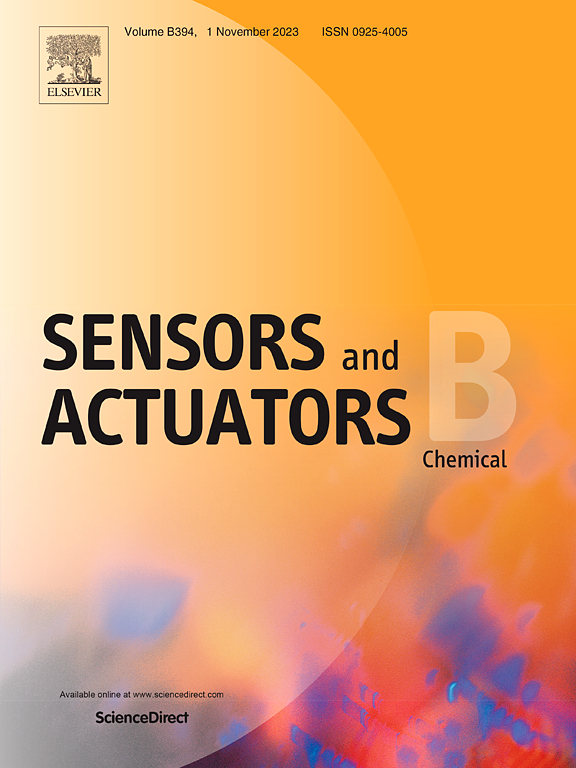Room-temperature response of Ni3(HITP)2 nanosheets co-functionalized with Au NPs and WS2 QDs based flexible chemiresistive NO2 gas sensor
IF 8
1区 化学
Q1 CHEMISTRY, ANALYTICAL
引用次数: 0
Abstract
Electrically conductive metal-organic frameworks (EC-MOFs) exhibit significant potential application as sensing materials for chemical resistance gas sensors. Herein, we developed a flexible gas sensor based on Ni3(HITP)2 nanosheets co-functionalized with noble metal nanoparticles (NPs) and WS2 quantum dots (QDs) for NO2 detection at room temperature. The gas sensing performance was regulated by optimizing the metal species and loading ratios of WS2 QDs. The measured results revealed that Au NPs and 2 mol% WS2 achieved the most effective enhancement for NO2 sensing performance. Therefore, Au NPs was selected to optimize WS2-2/Ni3(HITP)2 sensor for further improving the sensing properties. A unique hierarchical structure based on gas sensor (Au3@WS2-2/Ni3(HITP)2 sensor) enables high response (14.73 % to 5 ppm NO2), rapid response/recovery time (97 s/110 s), good selectivity, anti-humidity, repeatability, long-term stability as well as flexibility at room temperature. Furthermore, density functional theory (DFT) and band theory were employed to comprehend adsorption energies and the electronic structures at atomic scale, elucidating the intrinsic correlation between NO2 adsorption behavior and Ni3(HITP)2 surface and the sensitization mechanism of heterostructures. These findings provide novel insights for designing high-performance NO2 gas sensors worked at room temperature and guidance for EC-MOFs sensing mechanism.
基于Au纳米粒子和WS2量子点共功能化Ni3(HITP)2纳米片的柔性化学电阻NO2气体传感器的室温响应
导电金属有机框架(EC-MOFs)作为耐化学气体传感器的传感材料具有重要的应用潜力。在此,我们开发了一种基于Ni3(HITP)2纳米片与贵金属纳米颗粒(NPs)和WS2量子点(QDs)共功能化的柔性气体传感器,用于室温下的NO2检测。通过优化WS2量子点的金属种类和负载比例来调节其气敏性能。结果表明,Au NPs和2mol % WS2对NO2传感性能的增强效果最好。因此,选择Au NPs对WS2-2/Ni3(HITP)2传感器进行优化,进一步提高传感器的传感性能。基于气体传感器(Au3@WS2-2/Ni3(HITP)2传感器)的独特分层结构可实现高响应(14.73%至5 ppm NO2),快速响应/恢复时间(97 s/110 s),良好的选择性,抗湿度,可重复性,长期稳定性以及室温下的灵活性。此外,利用密度泛函理论(DFT)和能带理论在原子尺度上理解了吸附能和电子结构,阐明了Ni3(HITP)2表面对NO2吸附行为的内在相关性以及异质结构的敏化机理。这些研究结果为设计室温下的高性能NO2气体传感器提供了新的见解,并为ec - mof传感机制提供了指导。
本文章由计算机程序翻译,如有差异,请以英文原文为准。
求助全文
约1分钟内获得全文
求助全文
来源期刊

Sensors and Actuators B: Chemical
工程技术-电化学
CiteScore
14.60
自引率
11.90%
发文量
1776
审稿时长
3.2 months
期刊介绍:
Sensors & Actuators, B: Chemical is an international journal focused on the research and development of chemical transducers. It covers chemical sensors and biosensors, chemical actuators, and analytical microsystems. The journal is interdisciplinary, aiming to publish original works showcasing substantial advancements beyond the current state of the art in these fields, with practical applicability to solving meaningful analytical problems. Review articles are accepted by invitation from an Editor of the journal.
 求助内容:
求助内容: 应助结果提醒方式:
应助结果提醒方式:


